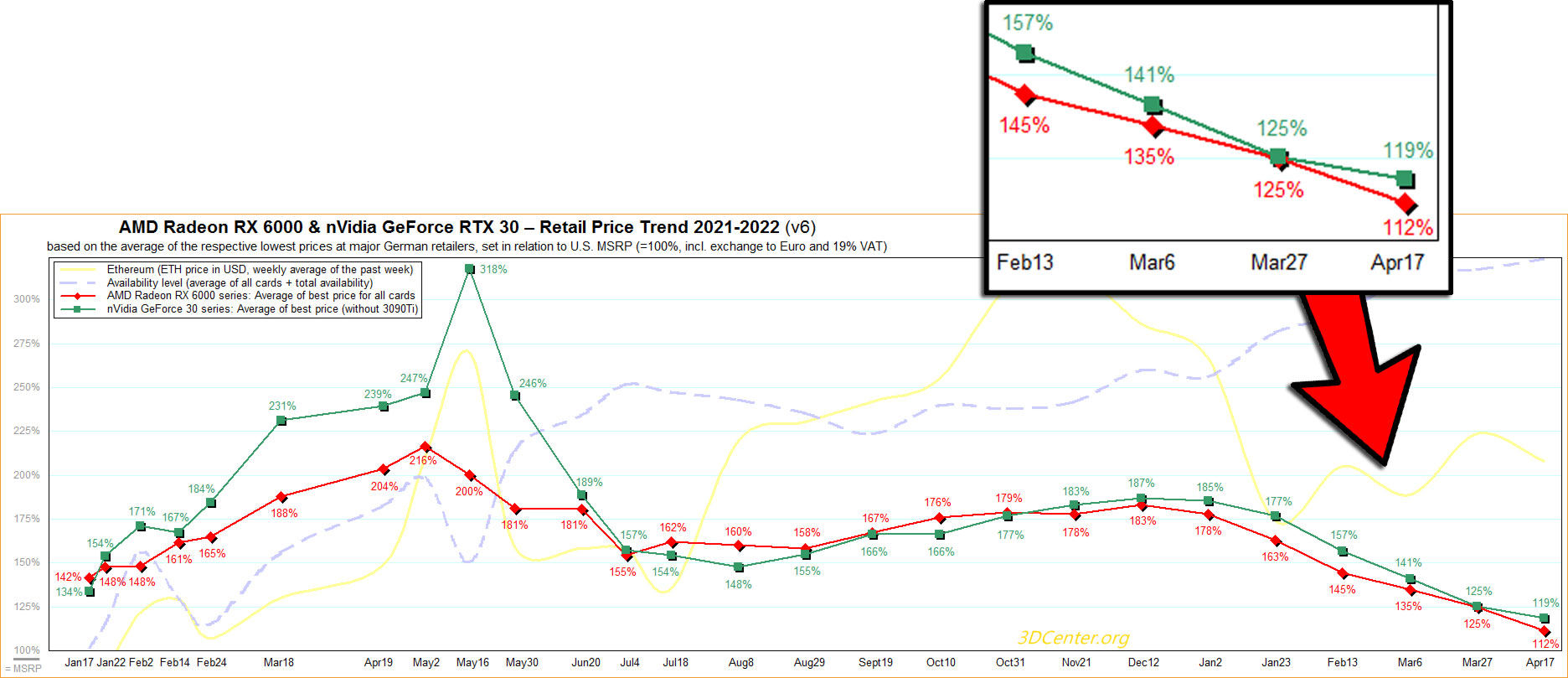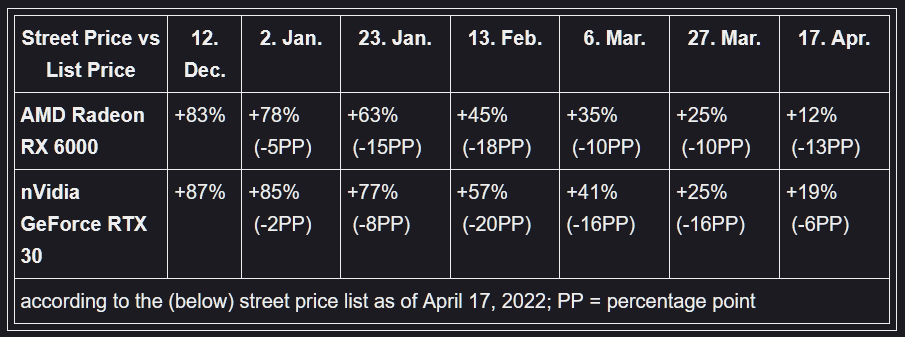Nvidia and AMD GPU Prices Continued to Plummet in April
But the rate of price decline has slowed for Nvidia GPUs.
Graphics card prices have continued to improve through April, reports 3D Center Germany in its Easter weekend roundup. Compared to three weeks ago, AMD GPU prices have declined 13% on average, while Nvidia GPUs have dipped by -6%. It is immediately evident that Nvidia's GPU price decline rate is slowing, as you can see in the graph below.
The Nvidia graphics card pricing curve appears to be flattening in April. The source site says that it may be an indicator that "the time of rapid price reductions is now over." However, these kinds of supply/demand pricing curves are not always smooth or so easily predictable.
3D Center's previous figures showed both Nvidia and AMD GPUs were both ~25% over MSRPs at the end of March. This might have been enough to tempt some Nvidia fans who had sheltered from the storm over the preceding months. On the other side of the equation, the Nvidia GPU supply might have slowed for some reason or other in the last few weeks. Obviously, something is different in Nvidia-world and AMD-land, as after both being 25% over MSRP at the end of March, Nvidia GPUs are now 19% over MSRP, and AMD GPUs are now 12% over MSRP, on average.
The source site is German and considers a host of online stores in the country to work out its average pricing and availability charts. The German market looks quite competitive as it charts nine eShops, and we know there will be graphics cards for sale elsewhere online, like at Amazon Germany or eBay Germany.
One other note about the German results is that they don't include GeForce RTX 3090 Ti cards. These halo GPUs were launched and made available at list price almost immediately, without much in the way of supply problems. Moreover, the RTX 3080 12GB isn't included as it doesn't have an official MSRP.
MSRP Isn't Low Enough, and Computex Is Coming
GPU pricing would normally be 10 to 20% below MSRP at this point in the refresh cycle. We think that AMD will do a last quick refresh of its Radeon RX 6000 series before it builds up for the Radeon RX 7000 launch later in the year. Meanwhile, the recently launched GeForce RTX 3090 Ti looks like the conclusion of the Ampere family, with Ada Lovelace GPUs due in the autumn.
With the next-gen graphics cards being pretty easy to wait for, this time in the GPU refresh cycle would normally only attract buyers with decent price cuts. However, if Nvidia's price decline doesn't change by the beginning of May, then its cards will end up 13% over MSRP by that time. Likewise, if AMD's price decline doesn't waver, the average price in early May will be at parity with MSRP.
Get Tom's Hardware's best news and in-depth reviews, straight to your inbox.
Ethereum cryptocurrency valuations seem to have largely decoupled from GPU pricing, which is welcome to see. However, perhaps the best news PC component bargain hunters could see are some convincing leaks regarding the capabilities and pricing of the next-gen GPUs from all parties.
Continuing to hold stocks of current-gen graphics cards gets ever riskier as people learn more about the appeal of Ada and RDNA3. Traditional trade show timelines suggest that we could learn quite a bit about the new graphics microarchitectures at Computex time (starts on Tuesday, May 24).
US Graphics Card Market
The above news looks at data from the German GPU market. We have our own monthly price watch, considering US pricing and availability once a month, the Tom's Hardware GPU Pricing Index. However, with the significant moves we observed last month, we also decided to add a mid-month update.
Having a quick nose around the US graphics card market this Easter, it is notable that Newegg appeared to have stocks of every GPU we checked for. Use the site's handy "in stock" power search toggle (upper left) to save you time and zero in on what is on offer – and available.

Mark Tyson is a news editor at Tom's Hardware. He enjoys covering the full breadth of PC tech; from business and semiconductor design to products approaching the edge of reason.
-
bigdragon Reply
Same. There's a variety of cards in stock at MSRP or slightly below. These are the inflated, top-end MSRPs though. When the MSRP is $720 for an RTX 3070 that Nvidia sells for $500, we've still got a problem. AIB MSRPs were artificially pushed up and need to come down. Paying MSRP is a mistake (that's on top of buying outgoing generation cards right before the new ones come out).peachpuff said:I'm seeing msrp prices locally, the drought is over... for now. -
Eximo Replybigdragon said:Same. There's a variety of cards in stock at MSRP or slightly below. These are the inflated, top-end MSRPs though. When the MSRP is $720 for an RTX 3070 that Nvidia sells for $500, we've still got a problem. AIB MSRPs were artificially pushed up and need to come down. Paying MSRP is a mistake (that's on top of buying outgoing generation cards right before the new ones come out).
We aren't going to see the launch price again. Costs went up for memory, substrates/interposers, and probably every capacitor and resistor on those boards. Shipping costs also went up with fuel costs. And they likely still don't have a surplus of GPUs to play with, so it still makes sense to concentrate on the cards with the higher profit margins. -
10tacle ^^Pretty much this. We are fortunate to have GPUs back in stock at retail price. Yes, I paid $1,299 retail for my EVGA FTW3 Ultra edition 3080 Ti from NewEgg last August on the shuffle lottery purchase win, and I was lucky to get that for my new mostly MSFS build. To put things into perspective last year, I was on both NewEgg and Microcenter's shuffle program for five months last year just to win the option to pay retail for any three of these: the 3070, the 3080, and the 3080 Ti (with any brand preference). It took that long to win just a buying opportunity, and then some hours thinking it over having that GPU in my cart when I really just wanted the 3080 which in the same EVGA FTW3 trim was $400 less.Reply
And make no mistake the shortage was worse for Nvidia GPUs over AMD GPUs because the demand was not there for AMD cards. Case in point? The $1,399 Radeon RX 6900 XT 16GB was avialable all last year on NewEgg and other E-tailers except during a short blip mid-summer. I know that too because I helped a buddy build his MSFS rig around the same time for his son and advised him to get the Radeon as it was the only thing in stock at "normal" price. A similar thing is happening with Xbox X vs. Playstation 5 where you can get the XB all day but the PS5 is either not avaialble at retail price (and you have to get on Sony's waiting list) or you pay scalping prices on E-tailers and eBay.
Things were so bad for so long that people needing a new build and wanting an Nvidia GPU were degraded to buying an inferior pre-built PC like from ABS on NewEgg just to get a high end or mid range GPU. I was about at that point. It is said people have short memories, and already I'm seeing comments out there from people still upset at high GPU prices even at retail price. Like Eximo said, that "normal" GPU price ship sailed long, and for a lot of reasons. The most expensive GPU I ever purchased was back in 2012 with the hot 2GB GTX 680 which retailed for $499 but after-market sold from like EVGA for $549 (mine was EVGA's Superclocked SC).
That's about $685 in today's US dollars. Now to put that GPU into performance perspective relative to today, a $650 8GB RTX 3060 that is available is about 5x as powerful. So when I see people saying the GPUs are just insanely more expensive these days, they are not taking into consideration the power increase for each generation over the previous one, even lower vs. higher tiers. Never mind the ever increased video game graphics demand and no increased monitor resolution and/or speed demands.
EDIT: I just checked NewEgg and my GPU is out of stock again when it was available yesterday at $1299. So people are still snapping GPUs up at all tiers. -
cryoburner Reply3D Center's previous figures showed both Nvidia and AMD GPUs were both ~25% over MSRPs at the end of March. This might have been enough to tempt some Nvidia fans who had sheltered from the storm over the preceding months. On the other side of the equation, the Nvidia GPU supply might have slowed for some reason or other in the last few weeks. Obviously, something is different in Nvidia-world and AMD-land, as after both being 25% over MSRP at the end of March, Nvidia GPUs are now 19% over MSRP, and AMD GPUs are now 12% over MSRP, on average.
These are not the official MSRPs announced by Nvidia or AMD, but the price-hiked MSRPs from AIBs looking to get a larger cut of sales targeted at crypto-miners last year. Call me when one can get something like a 3060 Ti for close to $400, or a 3080 for close to $700, their actual MSRPs. The next generation of graphics cards should be launching later this year, so anything much over those prices could end up looking like a rather poor value within a matter of months. It's possible that the new cards might target higher price points from the start, though I expect they will at least offer somewhat more performance-per-dollar than the initial 30-series pricing, even if it's not by a lot.
It seems likely that Intel will aim for competitive prices, as they usually do when entering a new market, and even if they don't initially offer any products competing at the "enthusiast level", if they price their cards well below similar-performing cards from the competition, that should have an effect on the pricing of those other cards. And you can be sure that AMD and Nvidia are concerned about another major player entering the market, and will do what they can to prevent Intel from stealing too much market-share from them. -
d0000h Reply10tacle said:Now to put that GPU into performance perspective relative to today, a $650 8GB RTX 3060 that is available is about 5x as powerful. So when I see people saying the GPUs are just insanely more expensive these days, they are not taking into consideration the power increase for each generation over the previous one, even lower vs. higher tiers.
Not so sure this is how it works for technology. CPUs today are 100-200x more powerful than yr2000, so what are you suggesting the price of CPUs should be today relative to then? Maybe a more fair comparison along that line is how many years will a card today allow me to play AAA titles at 75% graphics settings. If today's cards will last longer than 2012 cards then perhaps it's fair that they cost more(?)
Percentage cost of GPU vs whole the gaming system seems notably higher today than over the last 20 years. -
d0000h Reply
Yeah I'm a little worried the new cards are going to really stretch/increase the MSRPs based on what's happened over the last 2 years. Then the retailers will say "Well we're selling them at MSRP" and we're supposed to be like 'Yeah MSRP awesome'. I'm thinking some of the 3000 series Ti cards might look like a pretty good buy if found at a groovy price. Else will have to wait a fair while before new cards price settle down over 9-12 months.cryoburner said:The next generation of graphics cards should be launching later this year, so anything much over those prices could end up looking like a rather poor value within a matter of months. It's possible that the new cards might target higher price points from the start, though I expect they will at least offer somewhat more performance-per-dollar than the initial 30-series pricing, even if it's not by a lot. -
hannibal Maybe we see old gen Nvidia 3000 series and AMD 5000 series at MSRP +25 at the release of the next gen ;)Reply
Just interesting to see again MSRP +200% for the new GPU couple of minutes after the release... :rolleyes:
"May the bots be with you!" -
thisisaname Replyd0000h said:Not so sure this is how it works for technology. CPUs today are 100-200x more powerful than yr2000, so what are you suggesting the price of CPUs should be today relative to then? Maybe a more fair comparison along that line is how many years will a card today allow me to play AAA titles at 75% graphics settings. If today's cards will last longer than 2012 cards then perhaps it's fair that they cost more(?)
Percentage cost of GPU vs whole the gaming system seems notably higher today than over the last 20 years.
Could not agree with you more d0000h, and from my post history something I have been saving for some time.
From what I can see technology tends to get better and the price rise tended to not be coupled with now much better it was than the last generation (may even have got better and cheaper).
I can remember when you could pay £25 for 1MB ram stick no one is paying £8000 for a 8GB stick of ram today. The idea things cost more inline with how much better they are is a relatively new one and one I will be very happy when it stops happening. -
bigdragon Reply
Supply and demand works both ways. The current MSRPs for AIB cards assume that people are making $4 to $8 a day mining -- that's the thing that really pushed those MSRPs through the roof. Worse, artificial scarcity because of scalpers shoved resale prices sky high. Now, you're lucky to be making $2 a day on the same cards and supply is overwhelming the scalpers. Those MSRPs are going to get reacquainted with the console ecosystem if PC gamers continue to hold off on purchasing GPUs. A GPU that's delivering console-like graphics is not worth the ridiculous prices being demanded today.d0000h said:Yeah I'm a little worried the new cards are going to really stretch/increase the MSRPs based on what's happened over the last 2 years. Then the retailers will say "Well we're selling them at MSRP" and we're supposed to be like 'Yeah MSRP awesome'. I'm thinking some of the 3000 series Ti cards might look like a pretty good buy if found at a groovy price. Else will have to wait a fair while before new cards price settle down over 9-12 months.
Prior to the RTX 30-series, GPUs used to sell for below MSRP with multiple games bundled in. It's time we stopped accepting the higher prices and waited for things to correct back down to sane levels. Why spend $900 on a 3070 when you can get a PS5 for $400? Makes zero sense. Prices have a lot further to drop. Increasing yields and removal of tariffs should be counteracting whatever nonsense companies want to groan about with the supply chains that are good enough to not fix for 2 years.

